Physical Address
304 North Cardinal St.
Dorchester Center, MA 02124
A variety of common and uncommon structures may be identified in histologic and cytologic preparations that bear a striking resemblance to parasites, fungi, bacteria, or viral cytopathic changes. These infectious mimics may confuse the examiner and thus lead to erroneous diagnoses and potentially unnecessary or harmful treatments. Misinterpretation of special stains may also contribute to diagnostic errors. It is therefore essential for the pathologist to have a general appreciation for potential infectious mimics and pitfalls and how to recognize them in histopathologic and cytopathologic preparations.
When faced with a potential infectious mimic, it is helpful to pursue the following basic principles. First, obtain a good patient history. Features such as symptoms, age, immune status, and travel/exposure history may assist in implicating or excluding an infectious entity. Second, consider the histologic or cytologic background. Chapter 1 outlines the various inflammatory responses that are characteristic for certain types of organisms; these responses often help the pathologist to formulate a differential diagnosis, whereas the lack of an appropriate inflammatory response, particularly in an immunocompetent patient, may favor a noninfectious diagnosis. Similarly, structures that appear to be in a different plane of focus or seem incongruent with the histologic findings (i.e., are in an area of the specimen that would be unlikely for the suspected organism) should raise suspicions of an infectious mimic rather than a true microorganism. Third, consider that certain anatomic sites are more likely to harbor infectious mimics than others. The most obvious examples are organs that may become contaminated with food material such as the lung following aspiration and organs connected anatomically (even through a fistula tract) to the intestine.
In this chapter, we discuss the more common infectious mimics by the type of organism they most closely resemble: bacteria, fungi, parasites, and viral cytopathic change—recognizing that there is some overlap among them. We also provide a diagnostic approach that may help pathologists to avoid diagnostic misinterpretation.
Many small structures can mimic bacteria, including a variety of endogenous and exogenous pigments, intracellular granules or phagocytosed debris, and stain precipitate. To differentiate between mimics and true bacteria, is it best to use high magnification (600 × or 1000 × using oil immersion) to examine the shape and contour of the objects of interest. In general, bacteria have smooth outer contours and stain in a homogeneous manner. Bacteria appear as basophilic cocci or rods on hematoxylin and eosin (H&E), regardless of their Gram stain reaction, and they give the same Gram reactions on tissue Gram stains (e.g., Brown and Brenn, Brown and Hopps) as on the traditional microbiology Gram stain ( Figure 29-1 ). Gomori methenamine silver (GMS) and periodic acid Schiff (PAS) will stain both gram-positive and gram-negative bacteria and tend to outline their outer contour ( Figure 29-2 ). In contrast, bacterial mimics are often pleomorphic in size and shape and may have sharp or jagged edges. They may also not give the expected stain reaction with H&E, Papanicolaou (Pap), Gram, PAS, and GMS. Thus, morphologic features using common histochemical or cytochemical stains are usually sufficient for differentiating true bacteria from bacterial mimics.
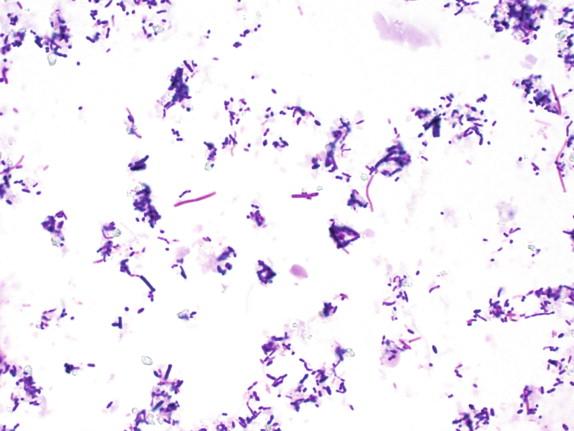
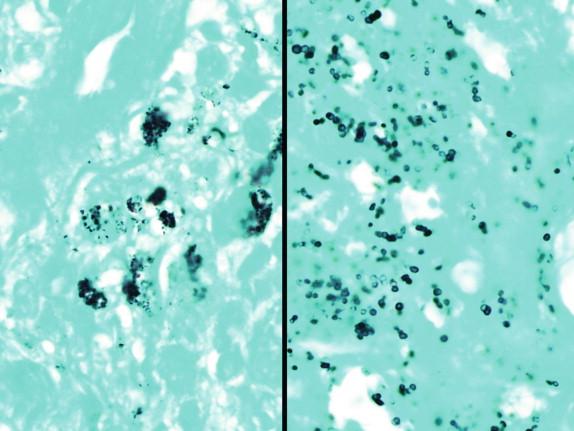
The following are common mimics of bacteria in histologic and cytologic preparations. Features for differentiating them from true bacteria are noted.
Pigment granules can present as convincing bacterial (and occasionally fungal and parasitic) mimics. They occur widely in histologic sections and most often represent naturally occurring endogenous pigments. Endogenous pigments may be related to normal skin coloration (melanin), physiologic processes (lipofuscin, bile), or pathologic conditions (accumulation of excess iron or copper). Pigments can also result from exogenous processes and materials, such as tattoos, inhalation (e.g., carbon), medications (e.g., minocycline), and even grossing room processing (i.e., “inking”). Unlike most true microorganisms, they are irregular in size and shape with jagged or uneven contours.
Melanin is perhaps the most well known endogenous pigment, as it is a universal source of skin coloration. Not only is melanin present in the skin, but it can also be seen in mucosal tissues and even lymph nodes and may be present in increased amounts following certain therapies or injury. In histologic sections, melanin appears as fine brown to black granules. The distinction between melanin and other pigments, including brown immunohistochemical reporter dyes, is important ( Figure 29-3 ). The location and distribution of melanin also help to define its nature. In skin, melanocytes are located in the basal layer of the epidermis and distribute melanosomes containing melanin pigment along dendrites to the keratinocytes. Once in the keratinocyte, the melanosomes are organized above the nucleus as a protective cap.
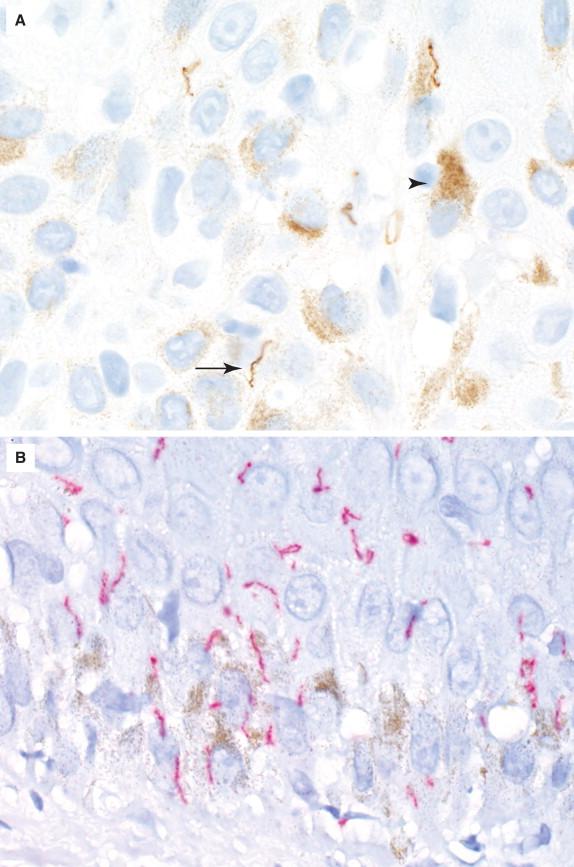
Melanin is also commonly seen in phagocytic cells (melanophages) in the dermis and elsewhere ( Figure 29-4 ). Melanin granules may stain positively with GMS, Fontana-Masson, and Warthin-Starry and thus be confused with bacteria or small yeasts, but they have irregular contours as well as size and shape pleomorphism. Immunohistochemical stains such as S100 and HMB45 are useful in that they highlight the melanin-producing cells. When the melanin pigment is particularly heavy, it can be bleached to reveal the underlying cells and tissues.
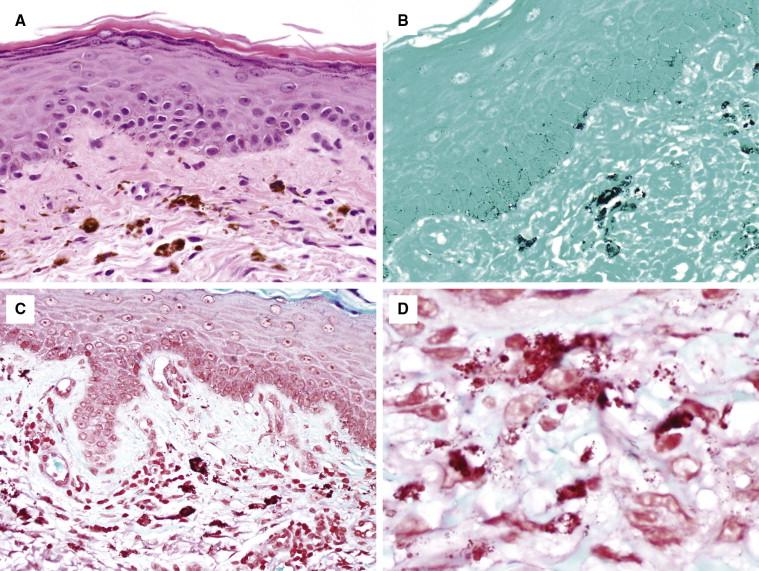
Formalin pigment consists of acid hematin and is formed as an artifact of tissue fixation in acid formalin. It is not typically seen in macrophages but instead often appears in clumps or small clusters in tissues with a lot of erythrocytes such as spleen, bone marrow, and areas of hemorrhage ( Figure 29-5 ). It is birefringent using polarized light.
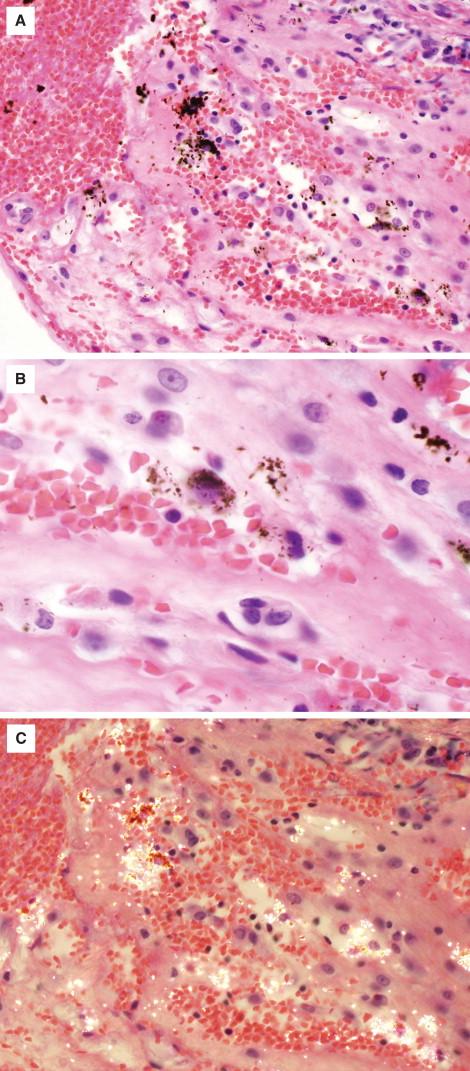
Hemosiderin is the cellular form of stored iron complexed with ferritin. It is typically formed as an erythrocyte breakdown product and is often seen in the spleen, bone marrow, liver, and areas of hemorrhage. Microscopically, it appears as intracellular, refractile, coarse, golden brown granules and takes on an “apple green” color when the condenser light is reduced. Unlike formalin pigment, it is not birefringent using polarized light. When there is doubt as to the nature of the pigment, Prussian blue can be used to stain the iron in hemosiderin a deep rich blue color.
Lipofuscin is a type of lipochrome pigment composed primarily of lipid and protein complexes, which forms due to oxidation of unsaturated fatty acids. It is considered to be part of the normal cellular aging process and is thus widely referred to as “wear and tear” pigment. Lipofuscin may also form as a result of damage to cellular membranes, mitochondria, and lysosomes, as seen with chronic injury and atrophy. Lipofuscin pigments appear as fine yellow-brown granules within parenchymal cells and macrophages and are common in the liver, kidney, heart, adrenal gland, and ganglions. With heavy lipofuscin accumulation, the granules may appear coarse and resemble hemosiderin. However, lipofuscin will not stain with Prussian blue like hemosiderin does, and it will stain positively with Sudan black B. Like hemosiderin, lipofuscin pigment is not birefringent using polarized light.
Carbon is an exogenous pigment (termed anthracotic pigment ) that enters the body through inhalation and accumulates within macrophages in the lung and regional lymph nodes. In histologic sections, carbon particles are black, variably sized fine granules that can be seen in both intracellular and extracellular locations (see Figure 29-6 ).
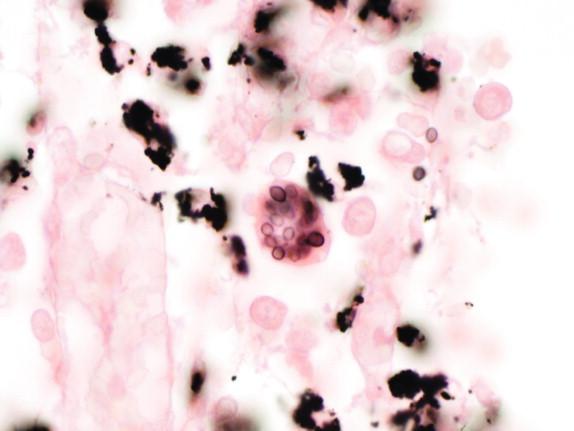
Tattoos are composed of a variety of dyes commonly injected into the skin. In histologic sections, the tattoo ink is present in the dermis as intracellular or extracellular granules, with minimal cellular reaction ( Figure 29-7 ). Some tattoos are not deliberately placed, such as amalgam in the gums after dental procedures or gold and mercury in other sites.
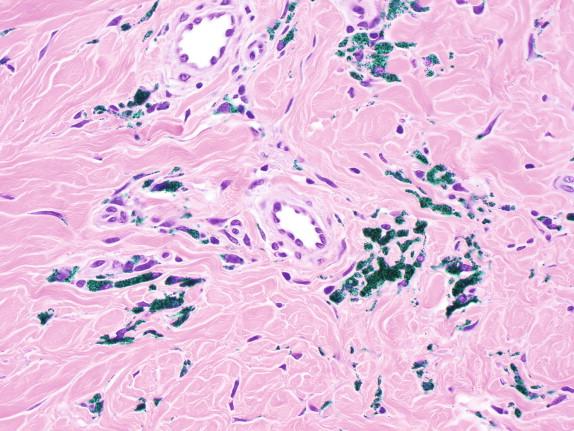
Prolonged administration of minocycline, an antibiotic of the tetracycline family, may cause the thyroid to become grossly black. The same pigment has been described in the substantia nigra in the brain and in the atheromatous plaques of patients receiving minocycline. The pigment is believed to be a mixture of neuromelanin and lipofuscin. This pigment is contained within lysosomes and stains positively with the Fontana-Masson stain and negatively with a stain for iron.
Degenerated melanosomes can be released from the retinal pigment epithelium during states of epithelial inflammation or when disrupted by malignancy and be seen in aspirated vitreous fluid as 1- to 2-μm brown-black objects ( Figure 29-8 ). Due to their small size and rod, elliptical, and fusiform shapes, they may be confused with a variety of microorganisms such as bacteria, tachyzoites of Toxoplasma gondii, and Leishmania amastigotes. They are differentiated from microorganisms by their brown pigment on Pap or H&E, small size, and lack of internal structures such as nuclei and kinetoplasts. They are blue-black on Giemsa-based cytology stains.
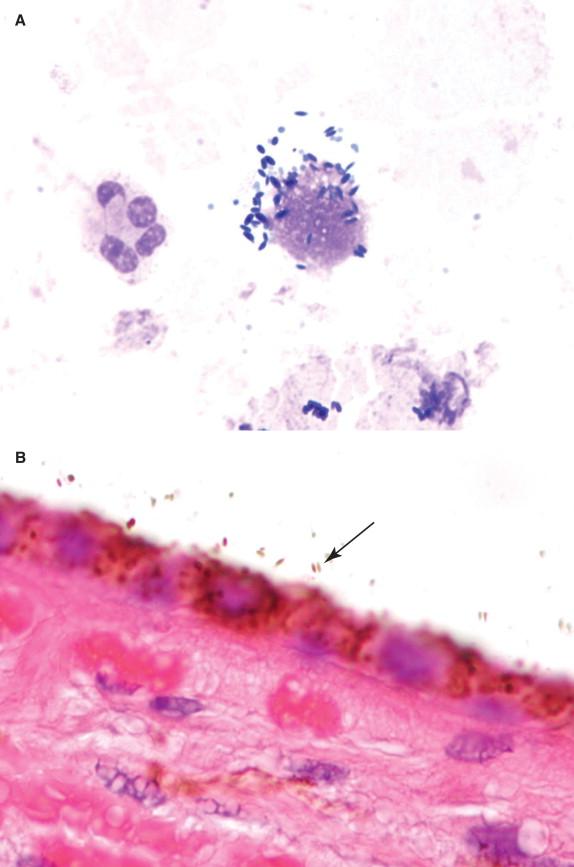
Pseudoactinomycotic radiate granules (PAMRAGs) are occasionally seen in cervical smears and biopsies and may be misidentified as true actinomycotic granules. Given that Actinomyces spp. are a known cause of pelvic inflammatory disease and tubo-ovarian abscess whereas PAMRAGs are nonpathogenic, differentiating these two entities may be important for patient management. On H&E stain, true actinomycotic granules appear as distinct granules with a dense core and fuzzy peripheral contour of indistinct basophilic radiating filaments, whereas PAMRAGS appear as partially refractile granules with irregular club-shaped peripheral projections and no central core. When in doubt, it is important to remember that Actinomyces filamentous bacteria are gram positive on Brown and Brenn (B&B) stain and are highlighted by with GMS stain, whereas PAMRAGs are negative for both stains ( Figure 29-9 ).
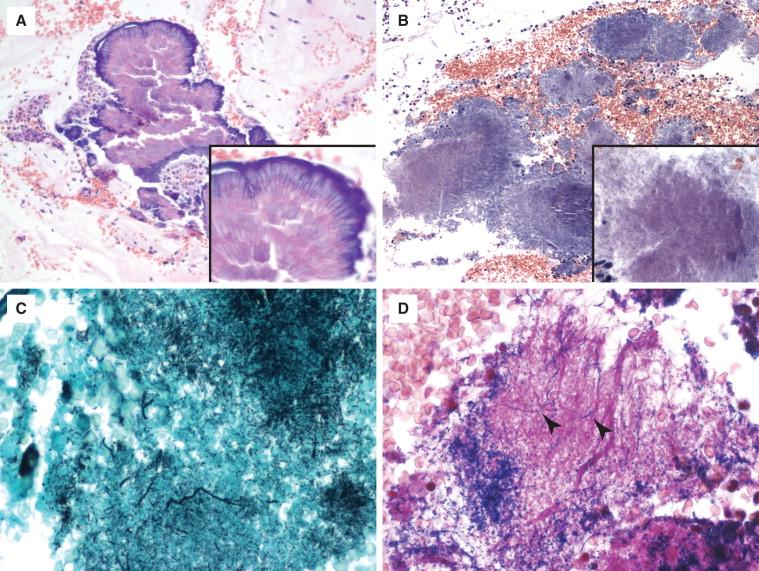
Mycobacteria are best identified by their rod shape and deep red color on acid-fast stains such as Ziehl-Neelsen (Z-N) or one of its modifications such as the Fite-Faraco stain. They have a regular caliber and blunt ends, and they often take on a banded or beaded appearance on acid-fast stains. These features help to differentiate them from the various acid-fast artifacts that may be seen due to stain-precipitate and nonspecific staining ( Figure 29-10 ).
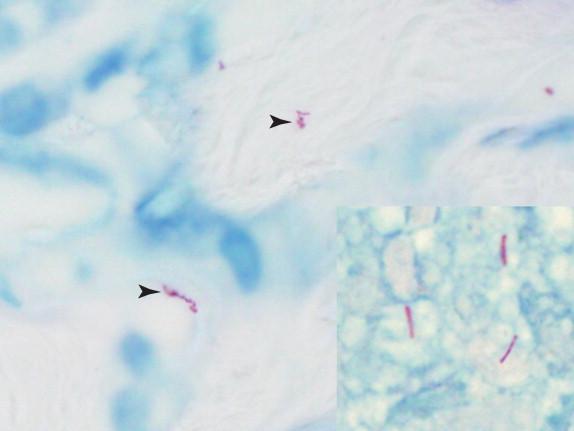
Nocardia and Rhodococcus species also stain with the Fite stain, whereas the hooklets of Echinococcus species will stain with both Z-N and Fite stains. Mast cell granules appear purple on acid-fast bacillus (AFB) stains and should not be confused with acid-fast bacteria ( Figure 29-11 ).
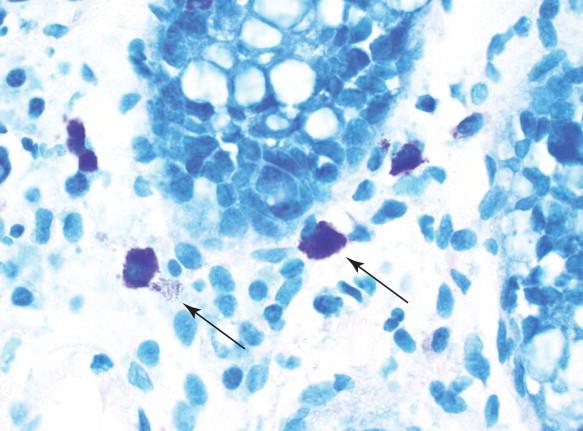
A special concern exists when a strongly positive control for acid-fast staining is placed on the same slide as the patient specimen, because the positive organism may come loose from the control tissue and inadvertently contaminate the rest of the slide ( Figure 29-12 ). This pitfall can be avoided by not placing the control tissue on the slide with the patient specimen, using a minimally positive control, or finding an alternative positive material that would not be confused with acid-fast bacilli. At the institution of one of the authors (BSP), ascospores of Saccharomyces cerevisiae mixed with ground turkey are used to create a positive acid-fast stain control ( Figure 29-13 ). This positive control material can be placed on the same slide as the patient tissue sections without fear of misinterpretation, even if positive ascospores inadvertently contaminate the patient tissue section, as the ascospores have a distinct appearance and would not be mistaken for an acid-fast human pathogen.
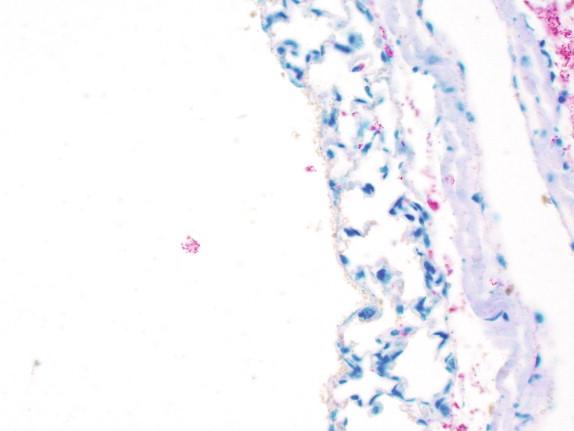
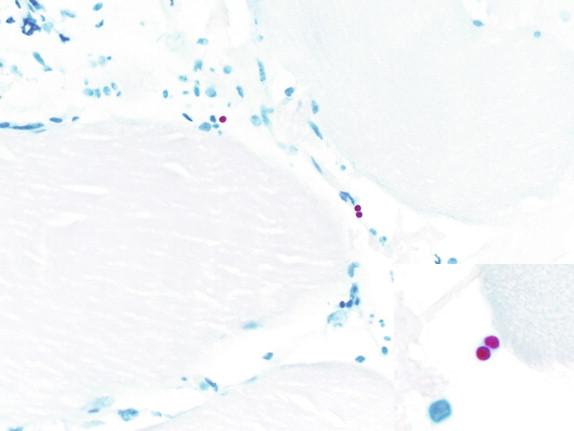
Finally, bacterial morphology may be altered by antimicrobial therapy and thus present a diagnostic challenge. For example, organisms may appear larger than expected ( Figure 29-14 ) or fail to give the expected staining pattern ( Figure 29-15 ). This is not surprising given that many antibacterial agents target the protein, nucleic acid, or cell wall synthesis of the infecting bacterium. Correlations with cultures, clinical picture, and overall morphology on multiple sections when possible are useful for confirming the diagnosis. Molecular testing with organism-specific polymerase chain reaction (PCR) assays or 16S rRNA gene sequencing may also be useful.
Pigment granules and stain precipitate are common in histologic sections; the anatomic location, color, plane of focus, variability in size and shape, and staining characteristics are useful for differentiating pigment granules and stain precipitate from bacteria and other microorganisms.
Melanosomes may be seen in vitreous fluid aspirates in states of retinal inflammation and must not be confused with bacteria, tachyzoites of Toxoplasma gondii , or amastigotes of Leishmania species.
Pseudoactinomycotic radiate granules may be seen in endocervical and endometrial specimens and must be differentiated from true actinomycotic granules so that the patient is not inappropriately treated; differentiation is accomplished through careful examination of morphology on H&E, Gram, and GMS stains.
Precipitation of carbol-fuchsin-based stains for mycobacteria may create structures resembling true microorganisms and may also stain mast cells, thus creating potential pitfalls for mycobacterial identification.
Previous antimicrobial therapy may alter the morphology of bacteria and other microorganisms on commonly used stains; correlation with cultures, clinical picture, overall morphology on multiple sections when possible, and molecular studies are useful for confirming the diagnosis.
Pigment granules typically have variable size and shape with irregular contours, unlike true bacteria, which are usually consistent in size and shape and have smooth outer contours.
Melanosomes in vitreous fluid are brown-black, 1 to 2 μm in length, and have a fusiform appearance with tapered ends.
Pseudoactinomycotic radiate granules are similar in size and shape to true actinomycotic granules but do not demonstrate slender filaments with Gram and GMS stains.
Carbol-fuchsin stain precipitation may create elongate structures resembling mycobacteria but typically have irregular ends or lack the banded appearance commonly seen with true mycobacteria.
Mast cell granules stain purple rather than bright red with carbol-fuchsin stains for mycobacteria and should not be mistaken as acid-fast-positive organisms.
Prior patient administration of antimicrobial agents can cause bacteria to enlarge, elongate, and demonstrate significant size pleomorphism. Antibiotic use may also result in failure to produce expected reactions with Gram stain.
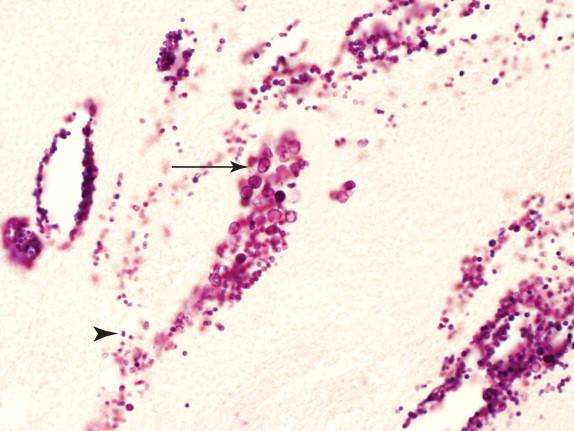
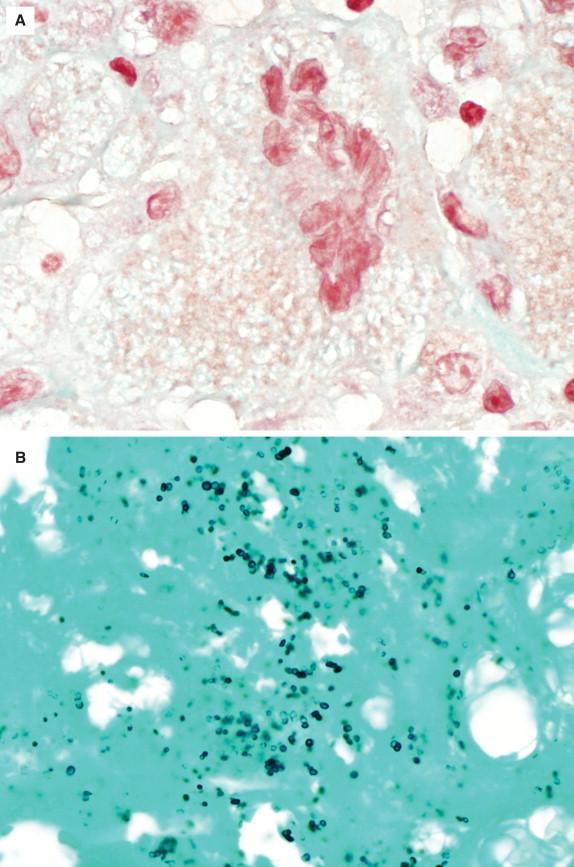
Like bacteria, many structures can mimic fungi, including a variety of mineralized or proteinaceous materials, intracellular granules or phagocytosed material, and certain host structures. Fungi are often (but not always) readily visible by H&E and stain with GMS and PAS (see Chapter 1 for expected staining reactions). However, it is important to remember that GMS and PAS are nonspecific stains that highlight a variety of organisms and infectious mimics in addition to fungi, including most bacteria. To differentiate between mimics and true fungi, is it best to use high magnification (600 × or 1000 × using oil immersion) to examine the shape and contour of the objects of interest. In general, fungi have smooth outer contours and stain in a homogeneous manner, whereas fungal mimics have considerably greater size variability, contour irregularity, internal structure variation, or exhibit unexpected staining characteristics. Measuring the size of the objects with an ocular micrometer may also be necessary. Fortunately, a careful examination of morphologic features using traditional stains is usually sufficient for distinguishing fungi from fungal mimics and other microorganisms. The following sections discuss the most common fungal mimics and how to avoid pitfalls in fungal diagnosis.
Tissue calcification is a common pathologic process associated with necrotic or degenerated tissue. During this process, calcium salts along with lesser amounts of magnesium and iron are deposited intracellularly or extracellularly from the circulation or from the interstitial fluid into the region of damaged tissue, resulting in the formation of granular structures most commonly composed of crystallized calcium phosphate. These structures may be round to oval and resemble yeasts or may have elongated or even branching forms that resemble fungal hyphae ( Figure 29-16 ). They may be either eosinophilic or basophilic.
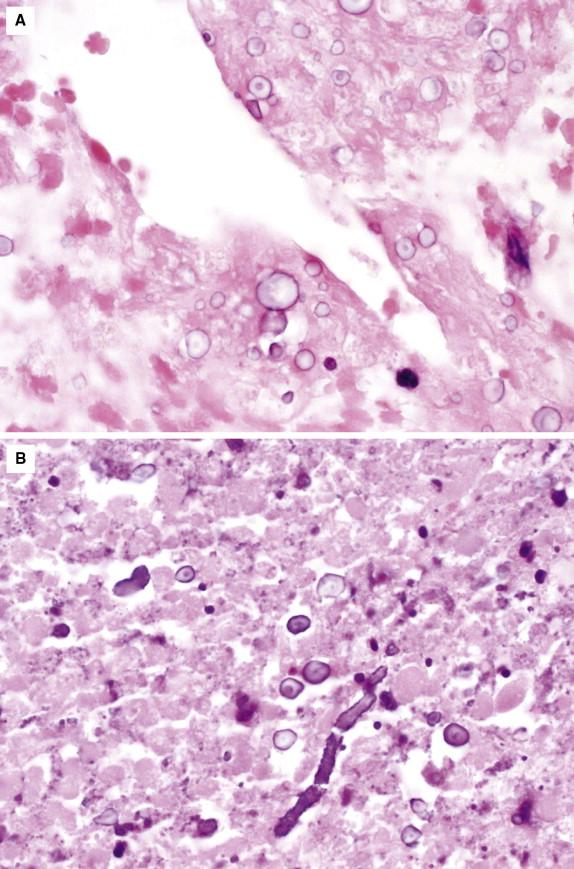
Unlike metastatic calcification, this form of calcium deposition (known as dystrophic calcification) is not associated with increased circulating calcium levels and is instead associated with a variety of processes, including fat necrosis, fibrosis, hematoma, thrombus, atheroma formation, caseous or liquefactive necrosis, and brain damage due to certain congenital infections. Psammoma bodies are a form of dystrophic calcification seen in a variety of neoplastic and non-neoplastic processes. They appear as round or oval calcified structures with concentric lamellations. Michaelis-Gutmann bodies of malakoplakia are also a specialized form of calcification resulting from defective host cell phagocytosis, whereas asteroid hyalosis is a degenerative condition resulting in hydroxylapatite (calcium and phosphate) production in the eye; these phenomena are discussed further in the following sections on viral and parasite mimics and pitfalls. The Von Kossa histochemical stain for phosphate/carbonate can be used to demonstrate mineralization in tissue and differentiate calcium phosphate and calcium carbonate deposits from fungi and other microorganisms. In general, calcified bodies do not stain with GMS, which is also a helpful feature for differentiating them from fungi. Finally, calcified bodies typically have irregular contours and a size and shape unlike most fungi.
These variably sized eosinophilic structures are composed of amyloid and glycoproteins and are found in the prostate, brain, and, occasionally, the lung. Despite their similar appearance, differences in ultrastructural features have been observed among corpora amylacea in different organs, and different mechanisms may be involved in their formation. In the prostate, corpora amylacea are thought to be derived from degenerated cells and inspissated secretions, and they are seen within both benign and malignant glands. They occur more frequently with advancing age, although their significance is not well understood. In the brain, they are within astrocyte cytoplasm and are most commonly present in subpial and perivascular locations. They are also common in the aging brain and are found in increased numbers in individuals with Alzheimer disease and other neurodegenerative conditions. Finally, in the lung, they are located within alveoli with no discernible predilection for a specific lobe or segment. They may be surrounded by macrophages and have also been observed to occasionally contain a foreign body in their center.
Corpora amylacea are seen on H&E-stained sections as pink round, oval, elliptical, and even rectangular structures measuring between 30 to 200 μm in greatest dimension ( Figure 29-17 ). They typically have a laminated appearance with delicate concentric lines.
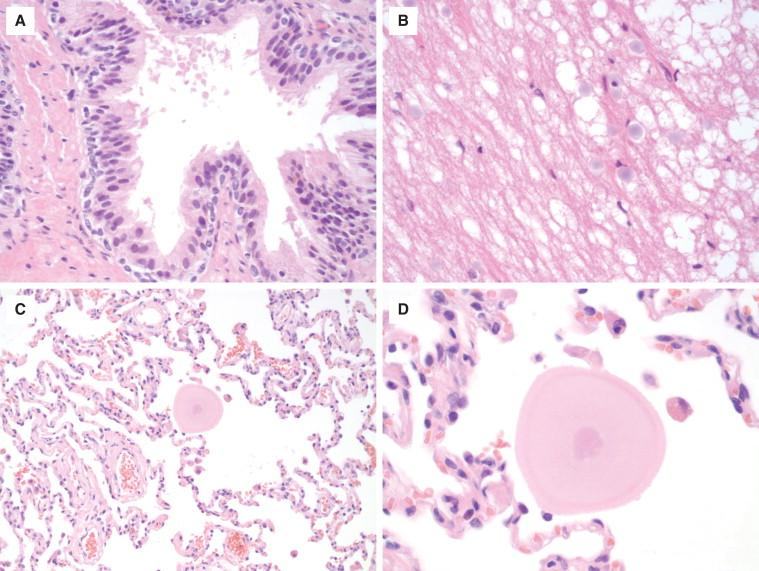
Corpora amylacea may be confused with fungal organisms, particularly in the lung and brain. They do not contain lipid or iron but occasionally contain calcium, and they often stain with GMS and PAS. Their laminated appearance, dense core, and lack of true budding allow them to be differentiated from fungi.
These structures are variably sized yellow-brown objects with irregular contours consisting of dense collagen and elastic fibers encrusted with calcium salts and iron ( Figure 29-18 ).
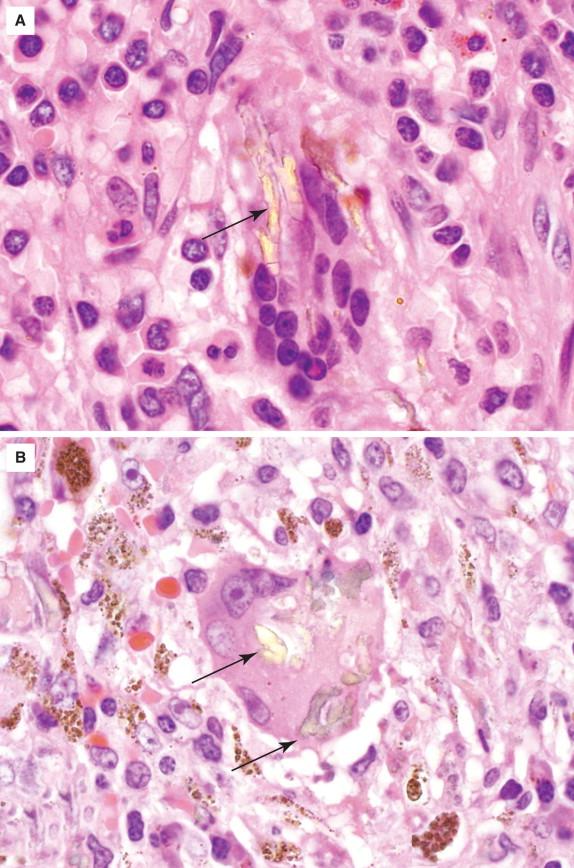
Gamna-Gandy (G-G) bodies are also known as siderotic nodules, Gamna-Gandy nodules, and fibrosiderotic nodules. They were named after Charles Gandy and Carlos Gamna, who studied them in the early 20th century, and they were initially thought to be fungal hyphae due to their fiber-like and articulated appearance with occasional branching. It later became apparent that they were noninfectious structures formed during organization of small hemorrhages, typically in the spleen, with associated hemosiderin and calcium deposition. Gamna-Gandy bodies are most commonly seen in the spleen and have been identified in up to 12% of patients with portal hypertension and congestive splenomegaly. Less commonly, they are seen in the spleen in patients with acquired hemochromatosis, sickle cell anemia, and paroxysmal nocturnal hemoglobinuria, and they have been also reported in cases of atrial myxoma, thyroid adenoma, thymoma, and renal cell carcinoma. The formation of G-G bodies appears to be the same regardless of the tissue in which they are identified. A similar phenomenon referred to as pseudofungi has been described in lymph nodes and may represent the same physiologic process.
Gamna-Gandy bodies can vary in greatest dimension from a few micrometers to several millimeters and can often be identified by imaging techniques such as ultrasonography, computed tomography (CT), and magnetic resonance imaging (MRI). The brown-yellow pigment of G-G bodies is due to the presence of hemosiderin and can therefore be confirmed with a stain for iron such as Prussian blue. They do not typically stain with GMS but may be PAS positive. These staining characteristics, as well as the irregular size and shape of these bodies, allow them to be differentiated from true hyphae.
Hamazaki-Wesenberg (H-W) bodies, also known as yellow-brown bodies, are small round to oval ceroid bodies found primarily in lymph node sinuses. They were initially described in mesenteric lymph nodes by Hamazaki in 1938 and later by Wesenberg in lymph nodes from patients with sarcoidosis. For several years, H-W bodies were thought to be associated with sarcoidosis, but this was later disproved after H-W bodies were found in numerous asymptomatic patients as well as patients with appendicitis, colon carcinoma, cirrhosis, and other medical conditions. Autopsy studies have found H-W bodies in more than 20% of all lymph nodes examined throughout the body, with the highest prevalence found in mesenteric lymph nodes (up to 70%).
Although H-W bodies have no known medical significance, they represent an important histologic mimic of yeasts in lymph nodes. Hamazaki-Wesenberg bodies stain with the commonly used fungal stains, GMS and PAS, and sometimes appear to have budding forms. However, they can be differentiated from true yeasts by their location (typically lymph node sinuses), yellow-brown color on H&E, size variability, occasional elongate forms and tapered ends, and lack of associated host immune response ( Figure 29-19 ). The core of the H-W body stains more intensely than the periphery in some instances. Hamazaki-Wesenberg bodies also stain with Fontana Masson, which is negative in most fungi with the exception of Cryptococcus neoformans/C. gatti .
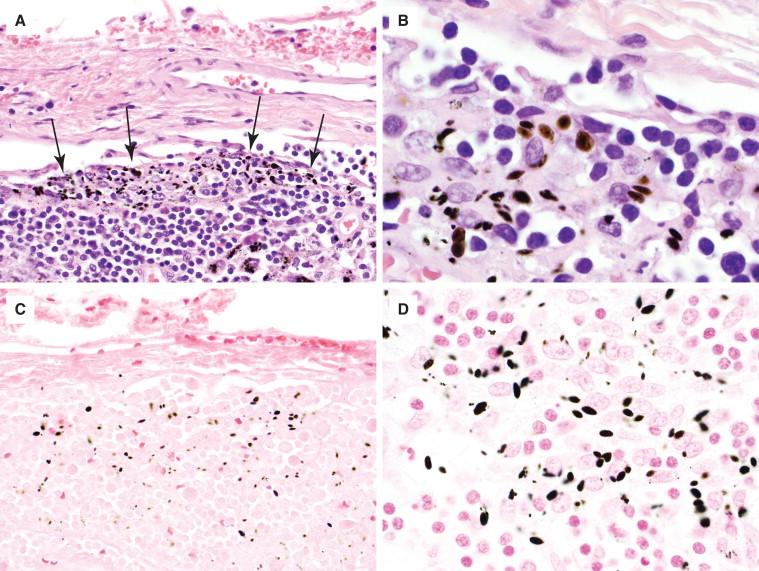
Liesegang rings or bodies are uncommonly observed laminated structures associated with benign cysts and inflammatory tissue in a variety of organs. They have been most commonly reported from renal cysts, but they have also been described in cysts of the breast, conjunctiva, and eyelid and within inflammatory tissue of the kidney, peritoneum, pleura, pericardium, omentum, fallopian tube, maxillary sinus, and epididymis. Liesegang rings typically develop in longstanding cystic or inflammatory lesions and are thought to form by a process referred to as the Liesegang phenomenon, in which organic material within a supersaturated solution precipitates periodically into zones (i.e., laminations) around a central nidus. This phenomenon was named after Raphael E. Liesegang, a German chemist who described concentric periodic precipitation of silver dichromate in 1896.
Liesegang rings are round to oval, vary in diameter from 5 μm to 1000 μm, and consist of a dense central core and outer rings with faint radial striations ( Figure 29-20 ). They are nonrefractile and are clearly visualized by H&E, Pap, AFB, B&B, and Masson’s trichrome stains. They also stain with Romanowsky-type stains such as Diff-Quik, but the laminated appearance may not be apparent. They are negative using GMS, PAS, Alcian blue, von Kossa, Congo red, Alizarin red, and iron stains, as well as with immunohistochemical stains for keratin AE1/AE3, hemoglobin, and epithelial membrane antigen. By transmission electron microscopy, they have an amorphous electron-dense core surrounded by fibrillary lucent concentric rings.
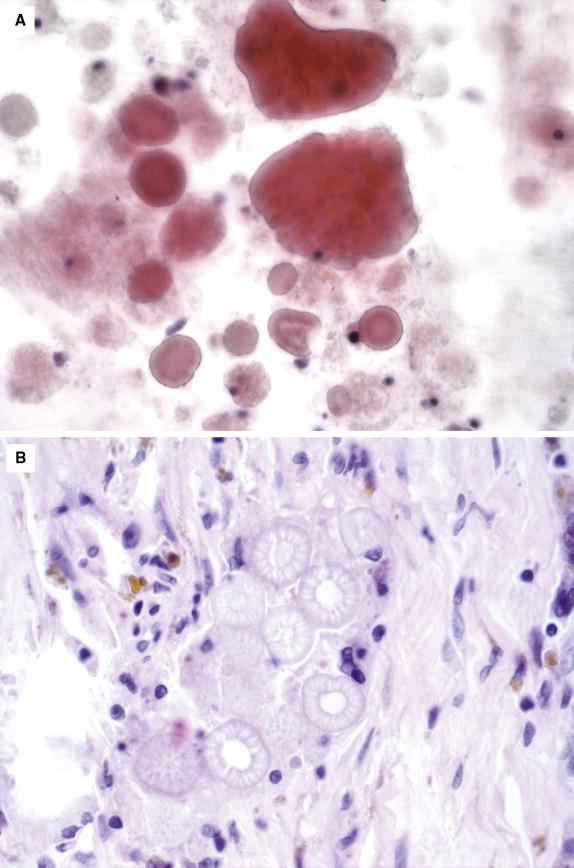
Given their size and appearance, Liesegang rings have been confused with parasites (e.g., Taenia eggs, Echinococcus protoscoleces, and eggs, larva, and adults of Dioctophyma renale, the giant kidney worm), nonspecific concretions and calcifications, amyloid deposits, mucin, corpora amylacea, Michaelis-Guttman bodies, algae, and pollen. In particular, Liesegang rings have a laminated appearance similar to the iron and calcium-containing Michaelis-Guttman bodies (seen in malakoplakia) and calcium-containing corpora amylacea. They are differentiated from these entities by their lack of staining for iron and calcium, location in the body, and association with inflammation and cyst formation. Similarly, they are differentiated from parasites by their staining properties and lack of internal structures, whereas their laminated appearance allows them to be differentiated from many other nonspecific materials and microorganisms.
Become a Clinical Tree membership for Full access and enjoy Unlimited articles
If you are a member. Log in here